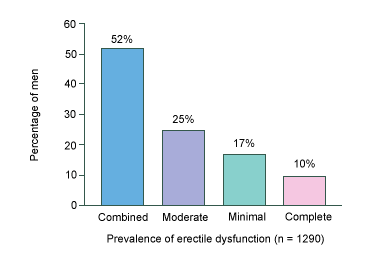
Ever since the ground-breaking work of Kinsey, the prevalence of erectile dysfunction has been a subject of debate. Although it is certain that many millions of men are affected by the condition, there is a surprising dearth of high-quality epidemiological data with which to quantify accurately the extent of the problem. A figure of one man in ten has often been quoted as an estimate of the prevalence of erectile dysfunction, but the frequency and severity of the disorder vary markedly with age. Erectile dysfunction is uncommon in young men (with the exception of intermittent psychogenic problems), becomes more common in middle age, and is highly prevalent in men more than 60 years of age. Thus, to some extent, erectile dysfunction is a natural expression of aging, but one that men are increasingly less willing to accept without seeking treatment. As the world’s population ages over the next few decades (Figure 1), the number of men who will suffer erectile dysfunction seems certain to rise.

Figure 1. The projected world population pyramid for 2002 (green) and 2025 (white) demonstrating how many more older people will be around to be affected by erectile dysfunction.
One problem for epidemiologists trying to quantify the extent and impact of erectile dysfunction is the frequent unwillingness of men to discuss the problem frankly. The accuracy of almost all data in this disease area is therefore impaired by the reluctance of many, particularly older, men to respond to what they regard as overly personal questions. However, with the development of simple questionnaires which can be self-administered, and the gradual breakdown of social taboos surrounding the open discussion of sexual issues, it is possible to anticipate higher-quality information in the future.

Figure 2. The proportion of men with either complete, moderate or minimal erectile dysfunction in the Massachusetts Male Aging Study.

Figure 3. Negative effects of erectile dysfunction on men's quality of life.
At this time, however, the best data available concerning the prevalence of erectile dysfunction are derived from the Massachusetts Male Aging Study (Figure 2). The findings of this study may be summarized as follows. A total of 1290 men aged 40-70 years were included in the study; erectile dysfunction was very common, with 52% of men reporting some degree of erectile dysfunction-mild in 17.1%, moderate in 25.2% and complete in 9.6%. Complete erectile dysfunction was reported by 5% of men at 40 years of age, rising to 15% at age 70 years. Loss of firm erections is often extremely bothersome to men. Figure 3 demonstrates the degree of worry, the loss of confidence, the negative feelings and the depression that can result.
No comments:
Post a Comment